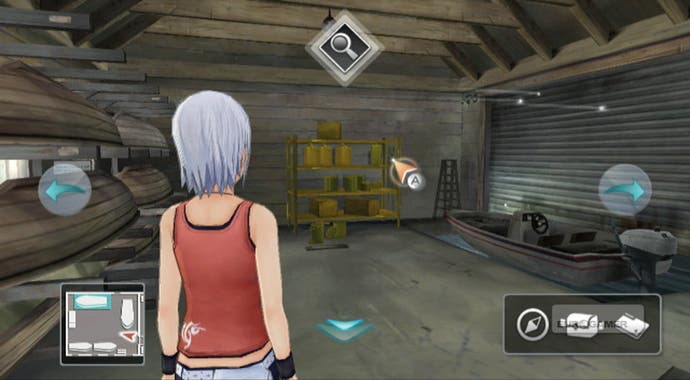Another Code R: A Journey Into Lost Memories
Murder, she clicked.
You can already guess that Lake Juliet doesn't have anything like the haunting, lonely atmosphere of the DS game's Blood Edward Island. It's a pretty, open and reassuring place, thickly peopled with mostly amiable characters, and Ashley is often in company and almost always talking to someone. The pleasantly bland location, combined with the excruciatingly halting dialogue style and ambling, meandering plotting, means there's no sense of urgency or intrigue to Another Code R at first, and it takes a long time to build up. You're often forced down cul-de-sacs and byways in the plot as free exploration and curiosity are curtailed by some arbitrary decisions on what Ashley should be doing next.
Another factor is the cast of characters, most of whom seem rather shallow, if broadly likeable. They're attractively drawn and expressively animated, and they will get under your skin with time, but there's not much to them. The emotions expressed are poignant but plain, and the script can't match Hotel Dusk's sophistication, or the Phoenix Wright games' elegance, wit, pace and razor-sharp characterisation. Nevertheless, they do grow on you, as Another Code R itself does as it moves into its second act. The location starts to open up, the pace quickens, the plot-threads build until there are enough to sustain your interest, and the twin story lines begin to resonate nicely with each other.

The game's presentation is superb, too. Although it can be slow and marginally clunky to manipulate compared to the crisp 2D interactions of related DS adventures, it has a wonderfully clean and colourful 3D storybook style, and a logical, easy-to-use interface. Ashley runs between locations in a side-scrolling view, and investigates rooms in full 3D by standing in the centre and turning to face each wall. You can control the game entirely with the pointer, although basic movement is also mapped to the d-pad. Neat use of split-screen allows you to watch both sides of conversations and pick the animated mood, as much as the words, of Ashley's responses.
The first Another Code was known for its inventive use of the DS' stylus, twin screens and the form of the console itself in puzzles. The sequel does much the same for the Wii remote, which stands in for many objects and devices in the game, from test-tubes to flaps of cardboard. Sometimes these are amusing but disposable interactions to put you in the scene: throwing something, or shaking a test tube full of chemical solution.
But there are also several highly ingenious, fourth-wall-breaking puzzles that require you to really use your spatial imagination. Developers obsessed with punctuating their Wii games with novelty motion-control interludes should study Another Code R to see how it's done. Overall, puzzle design is very good, a little narrowly-defined at times but usually logical. Confounding moments of arbitrariness where you're reduced to clicking on everything with everything are rare.

In such a hyperactive, extravagant and attention-deficit medium as videogames, is it fair to mark a game down for daring to be understated? Because that's Another Code R's main quality, for better or worse - or rather, for better and worse. It's a beguiling and subtle piece of work, and a nice palate-cleanser. But it too often crosses the line from understatement to flat-out dullness, especially in its opening third. The sentimentality is touching, but rather earnest. The atmosphere, charm and writing aren't really there to pull you into the story before the game itself does, and the game takes its sweet time about that.
It's just not very compelling, and what might have made a pleasant, idle distraction in your pocket can't help feeling like a foot-dragging time-sink when sat on the sofa. Another Code R is a finely-crafted mystery adventure that's recommended for fans of the form with some time and patience on their hands, but anyone else looking for something engaging to read and solve might want to consider alternatives. Including the kind that comes printed on paper.
